Kurjenrahka National Park
Kurjenrahka National Park in Finland, in Finland Proper, is centred around the raised bog Kurjenrahka ("Crane bog"). Besides bogs and birdlife it features lakes and forests, among them the old-growth Pukkipalo. A large trail network, named after the old border stone Kuhankuono in Kurjenrahka, connects the park with Vaskijärvi nature reserve and centres of Turku, Yläne and other municipalities in the vicinity.
Understand
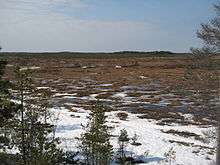
Most people come to the park by car for day trips. The park is also suitable for longer hikes and reachable by bike or coach (since 2013), or even by foot. There are lean-to shelters that can be used for overnight stays. Camping in tents is allowed at some locations and there are some commercial lodging facilities
There is some confusion about the Kurjenrahka National Park, the Kurjenrahka bog, the Kuhankuono trail network, the Kuhankuono stone, and the areas reachable by the trails, but the visitor does not have to care about the distinctions, as long as knowing the real destinations and any restrictions by the intended route (which vary also inside the park).
History
The area of the park raised from the Ancylus lake about 7000 years ago. There are findings in Saksala from the stone, bronze and iron ages. The Kuhankuono border stone is mentioned in a document from 1381. The areas was a commons, and most of the forests around the park are still administered as common land of the land owners in the area, although much has also been incorporated into individual properties and often later sold to the state. Much of the National Park area was bought from such common land. Permanent farms were established in the area from the 18th century onwards.
There was some forestry in most parts of the area, but exploitation was mild, because of difficulties in transportation. The nature values of the area were recognized quite early. In 1958 a decision was made to keep Pukkipalo as an old-growth forest. A decision to found the national park was made in 1976, but acquisition of the land was slow. The park was finally founded 1997.
Landscape
Different parts of Kurjenrahka National Park have very different character. The park consists of rather flat bogs surrounded by hilly forests (no steep or high ascends on the trail, few anywhere), with two lakes. Some of the forest is in the flat lowland, partly wetland forest. Much of the raised bog is forested, with a border zone of sparsely growing small trees towards wetter areas.
Flora and fauna
Climate
The climate of Finland Proper is temperate, with distinctive seasons. The conditions in the park are comparable with those in southern Finland in general, but the period with snow is much longer than in Turku, generally from late December to March. At snow melting time in March–April, some trails may be flooded. Spring is otherwise a nice time for bird watching. Most people visit the park in summer (May–September), but there is no reason not to come in autumn or winter, if you are prepared for the long dark evenings or are suitably equipped, respectively.
Get in
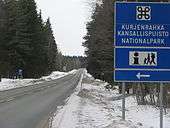
The park is about 35 km north of Turku. It is in reach by car, coach, local bus, bike or foot; there is a hiking trail all the way from Turku and a terrain bike route partly along the same route.
From late spring to early autumn there is a local bus connection from Turku all the way to the park entrance, otherwise it stops at a village 6 km away and a more expensive coach has to be used for short visits.
Information on the park should be available e.g. at Metsähallitus custom service points and at Turku tourist office. A brochure is available also as PDF.
The park consists of many areas intermingled with private land. Any of the areas can be reached for a day trip by car, taxi or bike, while the main day trip destinations for those dependant on bus or coach are Vajosuo and the trails in the area around Kurjenrahka and Savojärvi.
The unmanned nature information hut 🌍 Kurjenpesä is 700 metres west from the regional road 204 between Turku and Säkylä (take highway 9 from Turku towards Tampere, turn to road 204 after some 17 km, or use Paattistentie). A minor road leads from the 🌍 bus stop "Kuhankuono" to a parking area and the hut. An extension of the Haukkavuori trail leads from the bus stop to the hut as a footpath through the forest. Some of the coaches to Pori can be used; three to six times daily; one-way ticket from Turku about €10/7.50/5. In summer (2019: 23 April–22 September) there is also a local bus: the Tortinmäki buses (lines 21 and 23; €3/1.50) have their route extended to here six times a day in weekdays, ten times in weekends (the services on page 102–103 in the timetable booklet, see also announcement). From the hut there is a nature trail leading to the Kuhankuono border stone and also trails to Rantapiha, around Savojärvi, around Kurjenrahka and to several other destinations.
The 10 km 🌍 Haukkavuori trail leads to the national park from Riihikoski of Pöytyä. Coaches between Turku and Tampere pass six times daily ("Riihikosken tienhaara", 1.5 km from the trailhead, by national road 41; from Turku: €10/7.50/5).
There is local bus mostly once an hour from Turku (numbers 21 and 23; €3, children 7–14 €1,50) to Tortinmäki, about 6 km from Kurjenrahka (via the Töykkälä shelter) and Vajosuo. Start by 🌍 Järvijoentie (local road 2042/12430) and walk some 3 km through agricultural landscape, then through forest. By car or bike you can use the same roads. To Töykkälä there is also a "shortcut" through the forest, partly along small roads (for those coming by foot; some orienteering skills are needed)
The trail to Vaskijärvi starts at Elijärvenkulma, with parking. The coach from Turku towards Pori stops at the 🌍 Yläne crossroads, from where it is 7 km to the trailhead proper, mostly along minor roads (see below). With car you can use the Mynämäentie P area instead, 2,5 km from the trail but far from coach stops.
There are several parking areas, at nearly all trailheads, often near the main points of interest, such as
- 🌍 Rantapiha: turn west at Tortinmäki (Järvijoentie, road 12430), turn right at the T-crossing after some 6 km, turn right after some 3 km, drive 1 km.
- Kurjenpesä: see above
- 🌍 Töykkälä P area: turn west at Tortinmäki (Järvijoentie), drive some 4 km (gravel road Kukartintie after the Vajosuo crossing, just continue), turn right towards Töykkälä, drive 1 km (Vällintie). With car (or coming from Yläne/Säkylä) you could also drive via Karsonkulma: drive 3 km more along the Säkylä road, turn to the left and drive 3 km to Töykkälä.
- 🌍 Vajosuo P area: turn west at Tortinmäki (Järvijoentie), turn left after some 3 km and drive some 1,75 km
- 🌍 Pukkipalo P area: turn west at Tortinmäki (Järvijoentie/Kukartintie), turn right at the T-crossing after some 6 km, turn left after some 4 km and drive 330 m
- 🌍 Elijärvenkulma near Vaskijärvi: use the road 2020 between Mynämäki and Yläne (from road 204: drive to Yläne, turn to road 2020, drive 4,5 km, turn west towards Heinjoki and drive some 3 km).
- 🌍 Mynämäentie P area, 2.5 km from the Vaskijärvi trail, 6 km from Kajavanjärvi. Drive 10 km south-west from Yläne, 25 km nort-east from Mynämäki (the road is called Yläneentie in this end) or 21 km north-west from Tortinmäki (along Järvijoentie/Kukartintie and Saksalantie/Mynäjärventie).
The trail network extends far from the park. E.g. from Turku the park is reachable via Raisio and Masku by the Kullaanpolku and Suokulla trails and further along the Kuhankuono trails. The trail is marked on the outdoor map, as starting from Ruissalo near Turku harbour. With return by bus or coach from Kuhankuono, Tortinmäki or Yläne, this may be suitable as a long weekend hike for a fit hiker with some experience. You can take a regional bus from Turku to Raisio (€3/1,50; e.g. number 6 or 7) or Masku (Humikkala, near Riviera and Karevansuo) to more quickly get rid of road noise and not miss much but the Raisio river.
Fees and permits
There are no fees for entrance, hiking, camping at the lean-to shelters, using firewood at the campfire places or similar. There are some services available for fees at Rantapiha (phone +358 500-935-960), such as self service sauna (€1/person), camping, lodging, meals, boat rental, guided tours and a kiosk. Also other small businesses in the neighbourhood offer their services.
The nature cabinet in Yläne (phone +358 2 256-3127) can be used as starting point for longer hikes or visited before a hike. Open M W Th and Su 11:00–15:00 in June and July. Entrance to the exhibition €5/4. Five hour guided tour on the trails €120 (max 20 persons).
Picking berries and edible mushroom is allowed, except in Vaskijärvi nature reserve (and off trails in restricted areas during the restriction period). Otherwise nothing may be taken out of the national park, damaged or moved around. In areas outside the national park and nature reserves normal right to access applies.
In some areas of the national park, and in the nature reserves, trails must be used part of the year, see Get around below.
There are campfire sites at the shelters and at a few other places by the trails. Where these are properly built and firewood is provided, you can expect there to be a permission for making a fire (with due care) – unless a wildfire warning is in effect. As there are several entities involved in maintaining such services, some may not be properly marked on your map. Where there is only an improvised ring of stones and remains of campfires, expect them to have been made with specific permission not applying to you.
Get around
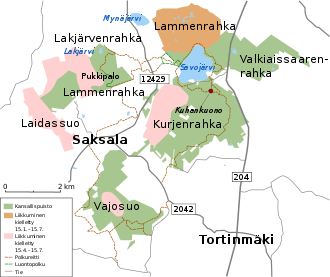
The trail network (partly the Kuhankuono network) connects all the areas of the national park and also near-by nature reserves. The trails follow minor roads some of the distance. You probably want the special map with trails and service marked ("Kuhankuonon retkeilykartta"; 1:55 000; €15), available, e.g. from Turku tourist office, Rantapiha and major book stores and outdoor shops. The 2015 map covers all the area from Turku to Yläne.
The online map of Metsähallitus works well for the national park, but services maintained by others (outside the park) are not well marked. The Kuhankuono online map is better for the connecting trails (but links in English from the Kuhankuono website are broken, here a hopefully working link, drag and zoom as needed).
There are duckboards over the bogs and in other especially wet areas, but the trails can be muddy also elsewhere in wet times. In spring, while the snow is melting, some of the trails may be covered with water.
Some trails and services near Kurjenpesä have been made accessible also by wheelchair.
In wintertime there are marked skiing tracks over the bogs. Maintenance is not guaranteed; do not rely on the tracks soon after snowfall. The summer trails can be difficult to use in winter. The distances are comparably short, so snowshoes are usable (but do not walk in the skiing tracks).
Several parts of the national park are restricted zones, as is the Vaskijärvi nature reserve, and entry to these is restricted to trails part of the year: April 15th to July 15th, Lammenrahka January 15th to July 15th, Vaskijärvi all year. This is no big deal for most visitors, since going out on the bogs in summer is quite onerous and even difficult. There are bird watching towers allowing views over some of the open bog areas.
The duckboards on the trail leg between the Töykkälä shelter and Kuhankuono are in bad shape as of 2016 (the trail is marked as "closed" in at least one end because of this); watch your step. In snow melting times the trail is probably difficult to use, as the boards are rotten on some stretches were they would be needed.
See
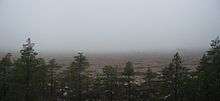
The main attractions are the bogs (Kurjenrahka and Lammenrahka, Vajosuo, Laidassuo and Lakjärvenrahka and those by Vaskijärvi), the lakes (Savojärvi, Vaskijärvi, Lakkjärvi and other small lakes), the old-growth forest of Pukkipalo, and the border stone Kuhankuono, where eight municipalities used to meet.
There is a rich bird life in spring and summer. There are bird watching towers at least at Vajosuo (🌍 Vajosuo tower) and at the eastern edge of Kurjenrahka (🌍 Koivusaari tower), and there is a good view from 🌍 Takaniitunvuori.
The nature information hut is nice and certainly worth a visit (unmanned, open 08:00–20:00).
The raised bogs are barren because the Sphagnum mosses continue their growth after they have lost contact with the original source of water, relying on rainwater instead. As the bog raises much higher than the surroundings, it gets no nutrients but what is carried by air, mostly by rain (the peat layer is several metres deep, developed during centuries). As the moss creates its own environment it does not develop uniformly, but wetter and drier parts are formed in an intricate feedback loop, with environments suiting different groups of species.
There is often a wetland at the edge of the raised bogs, especially where water from a hill flows towards the bog. These wetland do get nutrients by water from higher ground and thus have a very different flora.
There are several other types of wetland in the national park and its surroundings, as well as different kinds of forest.
Do
Hiking
The Kuhankuono trail network and Suokullan reitti have 300 km of marked trails. Possible routes include:
- By wheelchair or with baby carriage.
- The Kurjenpesä yard is accessible with wheelchair, including the toilets. The gravel road from the bus stop should be no problem. The trail to Kuhankuono – showing the most typical biotops, except the open raised bog – is accessible (gravel road or wide boardwalk), although the hillside down to the bog may be too steep with wheelchair unless you have assistance or motor. Also the short trail down to the Savojärvi shore by Kurjenpesä is very steep. In winter any road or trail is probably unusable.
- Day trips
- Circle route around Savojärvi (6 km), by Kurjenrahka and through Lammenrahka; start at Kurjenpesä or Rantapiha
- Circle route to Pukkipalo and Takaniitunvuori (6 km), start near Rantapiha
- Circle route at Vaskijärvi (19 km, 7 hr?): parking area at Elijärvenkulma, campfire sites outside the nature reserve at Vesirauma and Valastenmaa.
- Kajavajärvi, a sidetrip from the Vaskijärvi trail, which can be had as a 3.2-km circle route from Vesirauma if you come with bikes. Otherwise the parking is by Mynämäentie 4 km away, making it 12 km instead.
- Tortinmäki–Töykkälä–Koivusaari–Kuhankuono–Kurjenpesä (12 km?)
- Riihikoski–Kurjenpesä–Kuhankuono–Kurjenpesä–Säkylä road (15 km)
- Weekend hikes
- The above mentioned routes, possibly combined or extended
- Yläne–Vaskijärvi–Yläne (32.6 km): 4.5 km from the Yläne crossroads along Mynämäentie (road 2020), turn right to Honkalahdentie, turn left after 1.6 km, after 700 m (6.8 km in all) you reach the Vaskijärvi trail (there is also a somewhat longer route via lake Elijärvi: first turn already at Valasrannantie). There should be a lean-to shelter at least at Vesiraumanmäki, probably at least a camp fire site at Levonmäki and Valastenmaa (not maintained by Metsähallitus and thus not marked as services). These points and a large part of the trail are outside the nature reserve, so right to access should apply (and overnight stay is thus allowed).
- Circle route around most of the national park ("Vajosuon vaellus"; 25–30 km?): Kurjenpesä, Kuhankuono, Koivusaari bird watching tower, Töykkälä lean-to shelter, Vajosuo, Takaniitunvuori (Pukkipalo and Lakjärvi shelter by a 3-km detour), Rantapiha, Savojärvi (via either Lammenrahka or Kuhankuono), Kurjenpesä
- Tortinmäki–Kurjenpesä around most of the national park (25–30 km?): Tortinmäki, Vajosuo (with lean-to shelter), Takaniitunvuori, Pukkipalo, Lakjärvi (with lean-to shelter), Rantapiha, Savojärvi (via either Lammenrahka or Kuhankuono), Kurjenpesä
- Yläne–Vaskijärvi–Lakkjärvi–Rantapiha–Kuhankuono bus stop (35–55 km). Yläne–Vaskijärvi as above, circle the lake either way and continue to Rantapiha, then by either shore of Savojärvi and to the bus stop. Some sights and facilities require sidetrips from the shortest route, included in the higher figure: take the northern route around Vaskijärvi (with a campfire site), see Kajavajärvi, continue along the south shore of Vaskijärvi and use forest roads to the trail between Luhta and Isokorpi, continue to Soikeroinen with observation tower and lean-to shelter. Then hike via Takalevonkirkko and Särkijärvi lean-to shelter to Lakjärvi and Paltanvuori, walk half the Pukkipalo route counter-clockwise and continue to Rantapiha. The northern shore of Savojärvi has the nice Lammenrahka bog and better views to the lake. You can take a sidetrip to Kurjenpesä. Skip Kurjenrahka and Kuhankuono this time, as Kurjenrahka is better seen on a trip to the Koivusaari tower.
Cross-country skiing
There are skiing tracks over the bogs in the winter (see Get around above) and, except for Lammenrahka (north of Savojärvi) and Vaskijärvi, access is not restricted in winter, so all the bog area is easily accessible. Usability of normal narrow track skiing skis off tracks varies depending on snow conditions; if skiing off tracks is too arduous, just stay in the tracks. With "freestyle" (skating) skis the bogs are perfect in some conditions, but indeed not in others; there are no skate skiing lanes in the park.
Skiing in the forest is not always too easy, such as to the Töykkälä shelter, where the trail is used by non-skiers and the wood around it is dense much of the way. In other areas (and directly from Kurjenrahka to Töykkälä) it may be easier to find good routes. Keeping to the maintained skiing tracks and the bogs is the easiest option.
Bird watching
The bog has a rich bird life in spring and summer and there are bird watching towers at Vajosuo and Kurjenrahka (at Koivusaari by the Töykkälä trail). Also Takaniitunvuori offers a view to the bogs.
Berry and mushroom picking
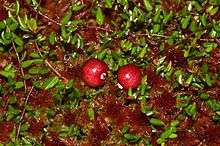
Berry picking is allowed except in the restricted areas. There is of course bilberry and lingonberry in the forests, and bog bilberry in the bogs, but in the bogs there is also cranberry and cloudberry, both regarded as delicacies. You could also taste black crowberry, which is edible but little used because of the small size and big seeds (juice, jam and liquor can be found in delicacy shops).
Wild strawberry can be found in small quantities (usually eaten on the spot), mostly on hills with sparse forest, from late June onwards. The bilberries get ripe a little later, in July, and lingonberry still later, with main harvest in August–September.
Cloudberries get ripe in late summer (changing colour to yellow). Cranberries are said to be at their best after the first freezing nights (which make them milder) and can be picked even in early spring.
Picking edible mushroom is allowed except in restricted areas. Usual warnings about poisonous ones apply.
Swimming, boating and sauna bathing
There are facilities for swimming in Savojärvi at Rantapiha and Kurjenpesä. There is a sauna at Rantapiha. There are probably also rowing boats and/or canoes for rent at Rantapiha (check!).
Buy
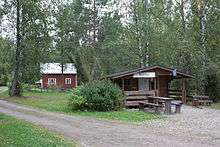
There is a kiosk/grill in Tortinmäki (6 km from the park). There is a kiosk at Rantapiha (check opening hours). There are several shops in Yläne.
Eat
Meals are served at Rantapiha if ordered in advance; coffee, snacks and ice cream are available at the kiosk.
There are campfire places at the lean-to shelters, at Takaniitunvuori hill south of Pukkipalo and at Levonmäki and Valastenmaa by the Vaskijärvi trail, with firewood provided for free. At Rantapiha and Kurjenpesä there are covered cooking places. Open fire is forbidden, also at maintained campfire sites, when forest fire warnings are in effect, and should be handled carefully at any time.
There are fire places also at the lean-to shelters (and some other places) by the trails leading to the national park, but maintenance of the shelters, and thus availability of firewood, is not guaranteed. Minor branches on the ground and similar can probably be used for a small fire at those locations – but in wet weather lighting the fire may require some skill.
Using a camping stove is allowed anywhere, also during wildfire warnings, provided due care. In dry conditions you probably should have water at hand, as making a mistake is surprisingly easy.
Drink
The water in the area is generally not potable, neither in the lakes nor in the Lakjärvi well, so water has to be carried. There is potable water available at Kurjenpesä and Rantapiha.
Sleep
Lodging
There are lodging facilities at Rantapiha and a rental hut at Vajosuo, as well as several small businesses offering lodging in the nearby areas.
Camping
There is a camping site at Rantapiha. There is an area for tents at Kurjenpesä.
There are three lean-to shelters by the trails in the park and some by the trails leading to the park. The locations are suitable for overnight stays at weekend hikes or hikes of several days, with some planning. Camping in own tents is allowed by the shelters. There should be pit toilets, campfire places and firewood at the shelters (but e.g. at Kullaanvuori and Töykkälä, the firewood was at a road some distance from the shelter in 2016).
- 🌍 Lakjärvi shelter north of Pukkipalo
- 🌍 Vajosuo shelter by Vajosuo
- 🌍 Töykkälä shelter by the south border of Kurjenrahka (fire wood is not in the woodshed, but under a tarp by the trail near the Töykkälä road, take some if you are coming from the south, otherwise you have to go to fetch it specifically).
By the trail from Turku:
- 🌍 Kullaanvuori shelter (nature reserve; several minor sights and an observation tower nearby)
- 🌍 Kerva shelter (at Rynkkiö, about 2 km north-northwest of Merttelä)
- 🌍 Halkokannisto shelter (on the north part of the Kangenmiekka circle trail, at the south part there is water available: Käärmelähde, "the snake spring")
By Haukkavuori trail:
- 🌍 Honkasaari shelter
By the trail northwards from the national park
At the Vaskijärvi trail, there probably is a lean-to shelter near the Vesirauma information board (🌍 Vesirauma shelter, not maintained by Metsähallitus and thus not specifically marked on the map).
Backcountry
In the national park, camping is allowed only by the shelters. In the Vaskijärvi nature reserve camping is not allowed at all. The right to access allows camping overnight in tents outside the protected areas, e.g. by the trails leading there and by the trail sections outside them. Considerations is needed though, as landowners should be kept happy about having the trails through their lands. Using grounds by the shelters only is recommended in most cases.
Stay safe
The area is not dangerous. Using reasonable judgement should be more than enough (as in not going out on some bogs and not getting lost in a snow storm). Mosquitoes can be a non-trivial nuisance, so repellents and long sleeves may be necessary in the evening. There are wolves and bears in the area, but you have to be lucky to see even a trace of them and no attacks on humans have been reported.
Go next
- Archipelago National Park in the Archipelago Sea